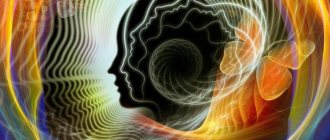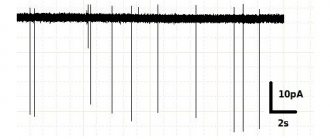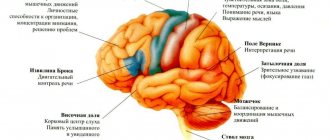All people experience feelings of anxiety and fear in different situations. A mother is worried about her sick child, a child is afraid of the neighbor’s dog, a grandmother is afraid of falling into ice, a novice motorist is afraid of getting into an accident... Why does the state of fear and increased anxiety in certain cases become the subject of study by psychiatry?
In all the examples given, there is a specific reason for anxiety and fear. Experiencing fear and anxiety in the face of real danger is the norm for a healthy person, the inclusion of protective mechanisms that help maintain health and life.
This kind of anxiety is called physiological. But if a person, as a result of the influence of mental disorders or psychological factors, including as a result of short-term intense stress or long-term mental overstrain, begins to constantly experience a feeling of fear or anxiety without any specific reason, we are talking about pathological anxiety.
You need to know that anxiety is a universal means that the human psyche uses as a warning about trouble. It may also indicate the emergence of a number and even most mental disorders. Experts speak of it as the cornerstone of psychiatry.
At the same time, when it comes to the neurotic level of anxiety, the following diagnostic names are usually used: anxiety neurosis, neurosis of fear and anxiety, generalized anxiety disorder (GAD). The latter name is given in the International Classification of Diseases (ICD-10), developed by WHO, but traditional terminology is still used in popular science literature and textbooks. Anxiety neurosis should be differentiated from phobias, since, despite the commonality - the irrational nature of fear - in phobias the object of fear itself is present. A characteristic feature of fear neurosis is to generalize an initially limited process into a widespread one, which in development has not only increasing mental, but also somatic, as well as vegetative manifestations.
What is Anxiety Disorder
A person experiences various anxieties throughout his life.
As a rule, they are a reaction to stressful situations occurring in everyday life, at work, and so on. However, we can talk about anxiety disorder as a disease only in cases where systematic anxiety significantly affects a person’s quality of life and forces him to adjust his lifestyle. Symptoms of anxiety disorders are extremely unique and depend on the type of disease. Today, there are generalized disorder and adaptive disorder, which has an alarming increase. Generalized anxiety disorder is characterized by constant excessive anxiety that envelops the patient in almost any situation, even the most mundane. In turn, people with adaptive anxiety disorder have difficulty adapting to stressful situations. Constant fear, worry, tension and anxiety in this disease can affect the functioning of various organs and systems: a person may be subject to rapid heartbeat, shortness of breath, a “nervous” stomach, and so on.
Is neurosis a mental illness, a neurotic disorder or a borderline state?
First of all, it should be said that the term neurosis is practically not used in foreign, especially American, psychiatric practice. Similar trends are also observed in domestic psychiatry. But among the people, the concept of neurosis does not lose its relevance and it is understood as different types of negative mental manifestations. Statistics show that 20-30% of the urban and 10-15% of the rural population have certain types of neuroses. About a quarter of all mental disorders are neurotic. In women and children they are more severe and develop more often than in men. In addition, women are more susceptible to the hysterical form of neurosis. From a scientific point of view, neurosis (psychoneurosis or neurotic disorder) is a group of neuropsychic disorders that are psychogenic in nature, reversible (functional) in nature and not accompanied by fundamental changes in the psyche. The psychogenic nature of neurotic conditions implies that the main causes of neuroses are internal or external factors that can cause psychological trauma, stress, emotional or intellectual overstrain. The term neurosis itself was introduced into medical practice back in 1776 by William Cullen, a doctor from Scotland. By the way, in a broad sense, neurosis is understood as functional disorders of higher nervous activity (HNA) and is used not only in medicine, but also in biology. It turned out that not only humans, but also higher animals can suffer from neuroses. According to the International Classification of Diseases (ICD-10), the category of mental disorders includes neurotic disorders associated with stress, as well as somatoform ones. The traditional division into neuroses and psychoses is not provided for in the ICD, but nevertheless is quite actively used in modern medical practice. The differences between neuroses and psychoses are that: • With neuroses, people are aware of their condition, are critical of it and retain the ability to control their behavior, i.e. a person is not divorced from reality. In psychosis, there is a disconnect from reality, delusions and various types of hallucinations. Between them there is a borderline state in the form of some disorganization of the psyche. All these divisions are arbitrary and sometimes it is quite difficult to distinguish neurosis from a borderline state. • Neurotic disorders do not have a physiological cause, but may have symptoms of a somatic illness and psychological manifestations that are painful for a person. But at the same time, unlike psychoses, psychotic symptoms and progressive personality changes towards degradation and dementia are not observed. • The root cause of neurosis is always a psychological factor. These can be external reasons (conflicts at work, business failures, family dramas, troubles with children, news of a serious illness, judicial review, etc.), as well as internal, hidden in the subconscious conflicts between a person’s needs and himself imposed bans on their satisfaction. In addition, factors predisposing to the development of neuroses may be: • Mental – character traits, conditions of upbringing and personality formation, its relationship with society, inflated levels of self-esteem and expectations. • Biological – disturbances in the functions and relationships of various neurotransmitters that increase the vulnerability of the individual to the effects of stress and psychological trauma. May be genetically determined or acquired.
Causes of Anxiety Disorder
The causes of anxiety disorders are explained by several theories from a biological and psychological point of view.
Biological theories. According to these theories, the disease is explained as a kind of biological anomaly caused by certain changes in the body. The most popular version of the occurrence of anxiety disorders is an increase in the production of neurotransmitters.
We should not exclude the possibility that it is the locus coeruleus that is responsible for the symptoms of the disease. It is located in the brain, namely in the stem part of it, and with electrical stimulation it becomes the cause of anxiety and fear. Medications that reduce the activity of the locus coeruleus and therefore reduce anxiety include propranolol, clonidine, and benzodiazepines. In turn, medications like yohimbine increase anxiety.
Psychological theories. From the point of view of psychoanalysis, anxiety is a manifestation that signals the presence of a forbidden need or a certain impulse that needs to be hidden and prevented from expressing the need. According to this theory, the symptoms of anxiety disorders are explained as containing an unacceptable need within oneself.
Phobias and anxieties in general, from the point of view of behaviorism, are considered as a reflex reaction to the sudden or expected appearance of frightening or painful stimuli. The brain gets used to this reaction and soon anxiety begins to arise regardless of whether there is a stimulus or not.
More recently, cognitive psychology has emphasized erroneous and distorted mental patterns that precede the onset of anxiety symptoms. For example, with anxiety disorders, patients may react in panic to seemingly standard sensations and ailments in everyday life (palpitations, mild headache). As a result, fear intensifies, and over time it grows and leads to a powerful panic attack. In domestic medicine, anxiety disorders are classified as a group of functional neuroses (a more modern name is neurotic disorders). According to the traditional classification, the disease is classified as psychogenic, which is characterized by awareness of the disease, a variety of symptoms and manifestations, as well as a complete absence of changes in consciousness.
What are the main signs of neurasthenia?
The symptoms of this condition are varied, but with a detailed clinical picture they are typical for most patients. The disorder develops in stages: • At the 1st stage, autonomic disorders are observed, among which tachycardia predominates even with light exertion, sweating, poor circulation in the extremities with coldness, as well as poor sleep and loss of appetite. The sensory reaction is significantly enhanced, especially the visual one, when a person is unable to tolerate even diffused light, closing the windows with thick curtains and staying in twilight. In addition, unexpected and sharp feelings of hunger may occur in response to the slightest appetizing smells and even innocent mentions of food. Often the extreme manifestations of increased sensitivity are severe headaches. • At the 2nd stage, sensorimotor disorders develop, the reaction to sensations from the internal organs increases. Increased sensitivity to temperature changes - severe chills in cool weather and increased sweating in hot weather. Noise in the ears, sensations of the work of one’s own heart and stomach, which a person normally does not feel and does not even think about. Signals from the body and its individual organs are so strong that they keep a person in constant tension, forcing him to react violently and anxiously to any changes on their part. • At the 3rd stage of neurasthenia, affective disorders with mood swings and an exaggerated response to even the most insignificant events join all this. People easily and quickly get offended, become whiny and irritable, every trifle or insignificant failure becomes a source of excitement and worry. For some, irritability develops into short temper, anger and resentment. In fact, there is an imbalance of neuropsychic and emotional processes, which leads to a decrease in intellectual abilities, concentration, understanding and memorization of abstract concepts.
Depending on the etiological factor, 2 variants of neurasthenic disorder are differentiated: • Neurosis of exhaustion of the nervous system, as a result of constant and significant overload. • Reactive neuroses, the cause of which is psychological trauma (acute or chronic). In addition, there are 2 forms of development of neurasthenia: • Hypersthenic with a predominance of irritability, increased sensitivity to external stimuli, muscle tension during neurosis, nervous tics and decreased attention. • Hyposthenic, which is characterized by rapid fatigue, a constant feeling of tiredness, decreased performance, lethargy and physical weakness. The neurasthenic state may be complicated by the addition of symptoms of other neurotic disorders. These can be hysterical reactions, obsessive fears and doubts, somatic manifestations, etc.
Symptoms of Anxiety Disorder
The symptoms of the disease are extremely extensive. Depending on the type of anxiety symptoms, according to ICD-10, the following symptoms are distinguished:
For anxiety-phobic adaptation disorders, the following are distinguished:
- Obsessive-compulsive disorder;
- Panic disorder;
- Post-traumatic stress disorder.
- Anxiety-phobic disorder:
- Reaction to acute systematic stress;
- Obsessive-compulsive disorders;
- Anxiety-depressive disorder;
- Generalized anxiety disorder;
- Panic disorder.
Panic disorder. The main symptom is panic attacks, which are periodically repeated, appearing in the form of discomfort and sudden fear. Symptoms of this condition are the following: fear of death, fear of becoming crazy, increased sweating, trembling, chest pain, shortness of breath, suffocation, rapid heartbeat, dizziness. Panic attacks usually last around 10-20 minutes. Patients often think they are having a heart attack.
Each subsequent attack intensifies fears and anxieties, to which another fear is also added - the fear of the next attack. Patients are more afraid not of the attack itself, but of the fact that it will happen at the wrong time or in places where it will be difficult for them to provide help. For this reason, patients begin to go around places with large crowds of people and completely deserted places. They stop walking alone and try not to leave the house at all. This phenomenon, which significantly reduces the quality of life, is known to science as Agoraphobia.
Some patients experience difficulties with anxiety disorders for many years of life due to constant relapses. Others manage to cope with the disease on their own - suddenly and spontaneously. There is also a third group of people who succumb to panic disorders and become couch potatoes, and this conditional status remains with them for several years.
Generalized anxiety disorders are characterized by a unique feature. This type of disease causes anxiety, which is not associated with any circumstances: situations, place of stay, and so on. Seizures are non-fixed and occur at any time and anywhere.
A diagnosis of anxiety disorder is made only when the symptoms of the disease have plagued the patient for at least 2-3 weeks. The most popular symptoms are:
- Fussiness, trembling, headaches, inability to relax and other types of motor tension;
- Difficulty concentrating, constant worry, worries about potential failures and other concerns;
- Dry mouth, epigastric discomfort, tachypnea, tachycardia, sweating, dizziness and other manifestations of autonomic hyperactivity.
Experts begin to talk about mixed anxiety and depressive disorders in cases where depression and anxiety are inherent in the patient, but they are moderately pronounced - not pronounced enough to determine a diagnosis.
In these conditions, diagnosis is quite problematic due to insufficiently expressed symptoms. The diagnosis of panic disorder is made in this case, rather, by exclusion. In generalized anxiety disorder, the symptoms are mild to moderate in intensity and the anxiety is vague but persistent. This is the main difference between this disease and panic disorders, in which attacks of excessively high intensity occur.
Generalized anxiety disorder is also called “free-floating.” This is explained by internal tension, a feeling of threat or potential misfortune that arises as a result of certain situations and conflicts of minor magnitude. In the eyes of patients, these situations have increasingly dire consequences; patients begin to consider all problems unsolvable. Often, in addition to anxiety, excessive aggressiveness appears. This disease negatively affects the musculoskeletal and autonomic-endocrine systems.
Most researchers agree that generalized anxiety disorder is not an independent disease, but rather a certain phenomenon of anxiety expressed in other diseases. For example, in its manifestation this disorder resembles anticipatory anxiety, which is a hallmark of panic disorder. However, unlike the same panic disorders, vegetative manifestations are involved to a lesser extent, while the prognosis of generalized anxiety disorder is more optimistic, and the disease itself begins more smoothly, gradually. As for the symptoms, they are not clonic, as in panic disorders, but tonic. Despite these differences between the two types of disease, the first disease can lead to the second, and the second to the first.
Social phobia is one of the manifestations of anxiety disorders. This phobia is expressed in excessive fear of experiencing embarrassment or humiliation in front of others, even strangers. This forces patients to avoid establishments where groups of people gather, as well as public speaking, being in large companies, and so on. As a rule, social phobia implies significant limitations in the patient’s life activities, and this often leads the patient to the next stage – Agoraphobia.
A simple phobia is expressed by excessive fear of specific situations, objects, creatures, and so on. There are a lot of examples of phobias: fear of heights, pets, snakes, airplanes, elevators, and so on. When meeting an object of fear, the patient always experiences trembling, horror, heart rate increases and sweating increases.
Obsessive-compulsive disorder is a combination of compulsivity and obsession (obsession). The latter is characterized by persistent impulses, thoughts or ideas, usually perceived as meaningless. For example, the thought of selling T-shirts, blasphemous thoughts, and so on. Patients realize the meaninglessness of these thoughts, but are unable to cope with this internal zeal. As for compulsivity, it is rather a reaction to obsessive thoughts that have arisen, aimed at neutralizing them and, accordingly, achieving psychological comfort. However, this behavior is senseless, and at the same time absolutely unreasonable.
Obsessive-compulsive disorders have several types. The most common is known as fear of dirt. Thoughts on the topic of pollution lead to the fact that patients try to stay in the cleanest possible places, and spend almost 2-3 hours a day washing. Another fairly popular type of obsessive-compulsive disorder is compulsive checking. Patients always check several times whether the iron, gas is turned off, whether the door is closed, and so on. In general, compulsive behavior is somewhat reminiscent of excesses in eating, drinking, increased sexuality, and gambling, but in the case of this disease, the thoughts and behavioral characteristics that arise are always unpleasant for the patient.
Post-traumatic stress is an illness that occurs after car accidents, rape, beatings, after war and other severe physical or psychological trauma. Patients, as a rule, repeatedly experience what happened, replaying the unfavorable situation in their heads. Memories can appear both in everyday activities and at night in the form of nightmares. The patient experiences mental numbness, becomes passive, does not experience positive emotions, and loses interest in work and hobbies. Also, post-traumatic stress leads to overexcitation, which is expressed by excessive fearfulness, nightmares, and insomnia.
Post-traumatic stress disorders are divided into three groups depending on severity. The first stage is a completely adequate reaction to trauma, which is expressed in maximum concentration on what happened. The patient is overcome with anxiety. The second degree occurs approximately a month after the incident, if the person is still haunted by memories of what happened. At this stage, nightmares intensify, emotionality practically does not appear, and the feeling of helplessness continues to grow. The third and final stage is loss of spirit and complete demoralization, loss of the meaning of life, despair.
With anxiety disorders, patients focus as much as possible on their shortcomings and cannot adequately form an assessment of themselves. As a result, people become withdrawn and insecure, and they start new acquaintances and relationships only when they know for sure that they will not be rejected. Rejection, as well as the loss of an existing person, is a strong moral blow for patients, so they prefer not to take risks and do not particularly establish relationships with people. However, loneliness is not an option!
The symptoms of anxiety disorders are multifaceted and varied. The main symptoms of the disease include:
- Avoidance of relationships with new people;
- Desire for relationships with society, bordering on extreme shyness;
- Self-isolation from society;
- High sensitivity to refusals and criticism;
- Disgust for one's own person;
- Extremely low self-esteem;
- Feeling of one's own inferiority;
- Desire to avoid physical contact;
- Shyness and embarrassment can be caused by the slightest preconditions;
- Lack of desire for intimacy;
- Timidity, modesty within unreasonable limits;
- Trust only yourself;
- Excessive self-criticism;
- Feeling of loneliness;
- Feeling of inferiority compared to other people;
- Chemical and mental dependence.
Signs
In a neurotic disorder, symptoms depend on the form of the disease. At the initial stage, the first alarming manifestation may be sleep disorders. A person has difficulty falling asleep, often wakes up, and the sleep itself is superficial and restless. As a result, the nervous system does not get enough time to recover, and the person’s general well-being deteriorates.
Frequent manifestations of the body during neurosis include:
- feeling of suffocation or a lump in the throat;
- heart rhythm disturbances;
- nausea;
- heartburn, belching;
- pain in different parts of the body;
- increased sweating;
- numbness of the limbs or cramps;
- constant low-grade fever.
The person is so mentally exhausted and irritated that he cannot be at rest. He knocks with his pen, fiddles with his clothes, jerks his leg or hand. In neurotic disorders, symptoms in adults may be associated with a change in social circles, a change of place of residence, seclusion, or alcohol abuse.
If you don’t seek help from a specialist, you can live in this state for years. This will lead to the emergence of a protracted chronic neurotic state, and as a result, a neurotic change in character. Coping with this will be much more difficult; psychotherapy is only effective over a long period of time.
Diagnosis of an anxiety disorder
The presence of the above symptoms does not yet indicate the disease. The diagnosis must be made by a psychiatrist, and in order for the specialist to recognize the problem and confirm the presence of the disease, the symptoms of anxiety disorders must bother the patient for at least 2-3 weeks.
Anxiety disorders diagnose . But identifying the type of anxiety disorder is quite problematic. The reason for this is similar symptoms in different types of disease. Its type and degree can be identified by analyzing the places and times of occurrence of symptoms. In general, in diagnosing anxiety disorders, the depression and anxiety scale, the Spielberger-Hanin test, the personality anxiety scale, and many others are used.
If you suspect an anxiety disorder, you need to gather yourself, adequately assess the situation and try to answer several questions for yourself:
- Are there feelings of fear and anxiety, problems with autonomic regulation and sleep disturbances;
- How long have the symptoms continued to bother you?
- Can the symptoms be associated with organic diseases? It is better to visit a doctor and check your health;
- Is there any systematicity in the appearance of symptoms (they happen in a certain place, under certain conditions, at a specific time, and so on).









